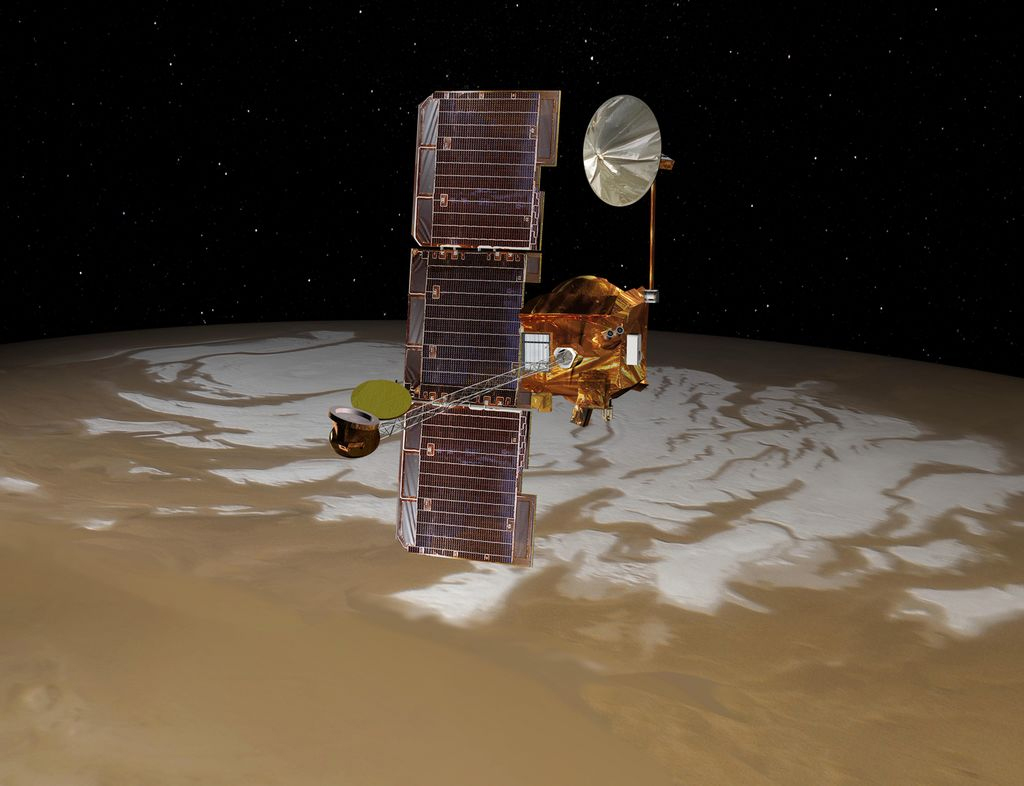
PASADENA, Calif. — Two NASA Mars orbiters will be ready and waiting to send home news of the Curiosity rover's landing attempt Sunday night (Aug. 5) — and one may even snap a photo of the daredevil maneuver.
Curiosity is due to touch down inside the Red Planet's Gale Crater at 10:17 p.m. PDT Sunday (1:17 a.m. EDT and 0517 GMT Monday) after being lowered to the Martian surface on cables by a rocket-powered sky crane — a move that's never been tried before on another world. NASA has billed the unprecedented landing as "seven minutes of terror."
Curiosity won't be able to tell its handlers directly how the touchdown attempt went, because Mars' rotation will take the rover out of direct contact with our planet a few minutes before landing. That's where the orbiters come in.
NASA's Mars Reconnaissance Orbiter (MRO) and Mars Odyssey spacecraft should both be overhead during and immediately after Curiosity's highly anticipated touchdown, NASA officials said. So Curiosity will speak through them, at least at first.
Odyssey will act as a "bent pipe," relaying Curiosity's signals to Earth as soon as it receives them. Since it takes about 14 minutes for communications to travel between Mars and our planet at their current separation, the mission team could know Curiosity's status as early as 10:31 p.m. PDT Sunday. [Images: How Curiosity's Nail-Biting Landing Works]
Odyssey's initial relay — or another one sent to Earth roughly two hours later, when the spacecraft passes over Curiosity again — could even include pictures from the rover, officials said.
"We expect that we might get some black-and-white, fisheye-lens Hazcam images," Richard Cook, Curiosity's deputy program manager at NASA's Jet Propulsion Laboratory, said in a press briefing here at JPL Saturday (Aug. 4).
Get the Space.com Newsletter
Breaking space news, the latest updates on rocket launches, skywatching events and more!
Curiosity has four pairs of Hazcams (Engineering Hazard Avoidance Cameras), which it will use to help map out the terrain it traverses.
MRO, on the other hand, must store data it receives onboard for a few hours before sending it on to Earth. So the news from MRO could be late compared to that from Odyssey. But it could also contain something spectactular — an image of Curiosity's spacecraft streaking through the Martian atmosphere.
MRO should be almost directly overhead when the 1-ton Curiosity rover — the heart of NASA's $2.5 billion Mars Science Laboratory (MSL) mission — touches down, officials said. And the orbiter will try to snap a photo of the momentous event with its HiRise (High Resolution Imaging Science Experiment) camera.
"We're going to attempt to have HiRise point at MSL in its final phases of descent and get an image of it going down," said Doug McCuistion, director of NASA's Mars Exploration Program. "I really hope we can get this image, but it's going to be tough."
The European Space Agency's Mars Express spacecraft, which is also orbiting the Red Planet, could help out with communications as well, officials said.
The first chance post-landing for Curiosity to communicate directly to Earth — which it did throughout its eight-month space cruise, sending signals picked up by NASA's three Deep Space Network antenna stations — should come around 6 p.m. PDT (9 p.m. EDT) or so Monday (0100 Tuesday GMT), Cook said.
The MSL team isn't assuming that the communication links will work perfectly and immediately, so researchers won't necessarily panic if 10:31 p.m. PDT comes and goes without any word from Curiosity via the orbiters. But they'll likely start worrying if the wait continues for 24 hours or so.
"I think once we get past that first day, we're definitely in the low-probability [of landing success] category," Cook said.
If all goes well Sunday night, Curiosity will be ready to begin its two-year mission, which seeks to determine if the Gale Crater area is, or ever was, capable of supporting microbial life.
Visit SPACE.com for complete coverage of NASA's Mars rover landing Sunday, Aug. 5. Follow SPACE.com senior writer Mike Wall on Twitter @michaeldwallor SPACE.com @Spacedotcom. We're also on Facebookand Google+.
Join our Space Forums to keep talking space on the latest missions, night sky and more! And if you have a news tip, correction or comment, let us know at: community@space.com.

Michael Wall is a Senior Space Writer with Space.com and joined the team in 2010. He primarily covers exoplanets, spaceflight and military space, but has been known to dabble in the space art beat. His book about the search for alien life, "Out There," was published on Nov. 13, 2018. Before becoming a science writer, Michael worked as a herpetologist and wildlife biologist. He has a Ph.D. in evolutionary biology from the University of Sydney, Australia, a bachelor's degree from the University of Arizona, and a graduate certificate in science writing from the University of California, Santa Cruz. To find out what his latest project is, you can follow Michael on Twitter.









